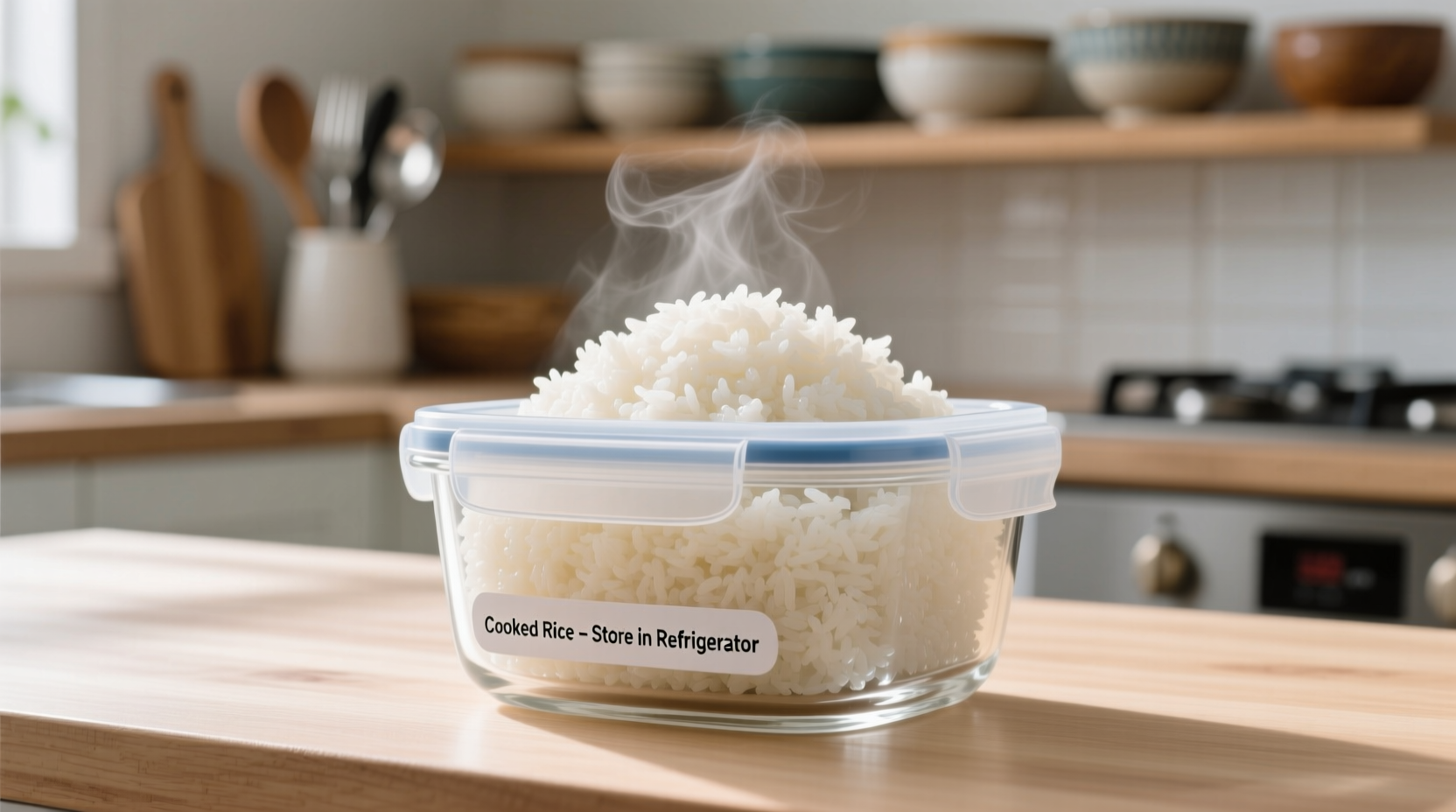Direct Answer: Cooked white rice stays safe in the refrigerator for 3-4 days when stored properly at 40°F (4°C) or below. Brown rice lasts slightly longer at 5-7 days due to its higher oil content. Always cool rice within 1 hour of cooking and store in airtight containers to prevent bacterial growth.
The Critical First Hours: Why Rice Spoilage Happens Faster Than You Think
Unlike many leftovers, cooked rice presents unique food safety challenges. The primary concern is Bacillus cereus, a bacteria that produces heat-resistant spores naturally present in uncooked rice. When rice sits at room temperature between 40-140°F (4-60°C), these spores can germinate and multiply rapidly, producing toxins that cause food poisoning—even if you reheat the rice properly.
According to the FDA Food Code, cooked rice must be cooled from 135°F to 70°F within 2 hours and from 70°F to 41°F within an additional 4 hours. This two-stage cooling process is critical for preventing bacterial growth.

Step-by-Step: Maximizing Your Rice's Refrigerator Lifespan
1. The Cooling Process (Most Critical Step)
Never place hot rice directly in the refrigerator. Instead:
- Spread rice in a thin layer on a clean baking sheet
- Cool at room temperature for no longer than 1 hour
- Stir occasionally to release trapped heat
- For faster cooling, place the container in an ice bath while stirring
2. Proper Storage Containers
Transfer cooled rice to airtight containers within 1 hour of cooking. Glass containers with tight seals work best as they:
- Prevent moisture loss that causes hardening
- Block odors from other refrigerator contents
- Allow for easy reheating without transferring
| Rice Type | Maximum Refrigerator Storage | Key Considerations |
|---|---|---|
| White rice (jasmine, basmati) | 3-4 days | Higher starch content creates ideal bacterial environment |
| Brown rice | 5-7 days | Higher oil content extends shelf life but increases rancidity risk |
| Sushi rice | 2-3 days | Vinegar content lowers pH but added sugar increases spoilage risk |
| Fried rice | 3-4 days | Eggs and meat ingredients shorten overall shelf life |
When in Doubt: The 4-Point Rice Safety Check
Before consuming refrigerated rice, perform these checks:
- Smell Test: Discard if you detect sour, funky, or unusual odors
- Visual Inspection: Look for discoloration, mold spots, or excessive moisture
- Texture Check: Rice should be separate and slightly firm—avoid if slimy or overly hard
- Time Verification: If you're unsure when it was cooked, err on the side of caution and discard
Safe Reheating Practices: Don't Skip This Step
Proper reheating is essential even with properly stored rice:
- Always add 1-2 tablespoons of water per cup of rice before reheating
- Heat to an internal temperature of 165°F (74°C) minimum
- Stir frequently for even heating
- Consume immediately after reheating—don't re-refrigerate
The Centers for Disease Control reports that Bacillus cereus causes approximately 63,000 foodborne illness cases annually in the United States, with rice dishes being a common culprit. Symptoms typically appear 1-5 hours after consumption and include nausea, vomiting, and abdominal cramps.
Special Considerations for Different Rice Types
White Rice Varieties
Standard white rice (jasmine, basmati, short-grain) has the shortest shelf life due to its high starch content. The starch breaks down more quickly, creating an ideal environment for bacterial growth. Always consume within 3-4 days for maximum safety.
Brown Rice
While brown rice can last 5-7 days refrigerated, its higher oil content means it's more prone to rancidity. Check for any off smells that resemble old cooking oil, which indicates the natural oils have gone bad.
Sushi Rice
The vinegar and sugar in sushi rice creates a slightly acidic environment that inhibits some bacteria, but the added sugar also provides food for other microbes. Consume within 2-3 days for best results.
Freezing: Your Best Option for Long-Term Storage
If you won't use rice within the recommended timeframe, freezing extends safety significantly:
- Portion rice into 1-cup servings for easy thawing
- Place portions in freezer bags with air removed
- Label with date and rice type
- Store up to 6 months at 0°F (-18°C)
- Thaw in refrigerator overnight or use directly from frozen
According to USDA Food Safety guidelines, frozen rice maintains quality for 6 months but remains safe indefinitely when kept at 0°F. The quality decline after 6 months is gradual, not sudden.
Common Mistakes That Shorten Rice Shelf Life
Avoid these frequent errors that compromise rice safety:
- Leaving rice out overnight to "cool completely"
- Storing in the original cooking pot with the lid on
- Using containers that aren't truly airtight
- Refrigerating in large batches instead of portioning
- Reheating multiple times
When Food Safety Guidelines Conflict: Resolving Differences
You might encounter varying recommendations from different sources. Here's how to navigate these discrepancies:
| Organization | Recommended Storage Time | Key Rationale |
|---|---|---|
| USDA FoodKeeper App | 4-6 days | Based on standard refrigerator temperatures (40°F or below) |
| FDA Food Code | 7 days maximum | For commercial food service with strict temperature monitoring |
| NHS (UK) | 1-2 days | More conservative approach due to higher average refrigerator temperatures |
For home kitchens, the 3-4 day guideline represents the safest middle ground. Home refrigerators often have temperature fluctuations that commercial units don't experience, making the more conservative timeframe appropriate.
Real-World Storage Timeline: What Happens Hour by Hour
Understanding the bacterial growth timeline helps appreciate why timing matters:
- 0-1 hour after cooking: Safe window for cooling—bacteria remain dormant
- 1-2 hours: Bacterial spores begin to germinate if temperature is between 40-140°F
- 2-4 hours: Rapid bacterial multiplication occurs—each cell divides every 20 minutes
- 4-6 hours: Toxin production begins—reheating won't destroy these heat-stable toxins
- 6+ hours: High risk of foodborne illness even after proper reheating
This exponential growth pattern explains why the "it's just a little longer" mentality with rice storage is particularly dangerous.











 浙公网安备
33010002000092号
浙公网安备
33010002000092号 浙B2-20120091-4
浙B2-20120091-4